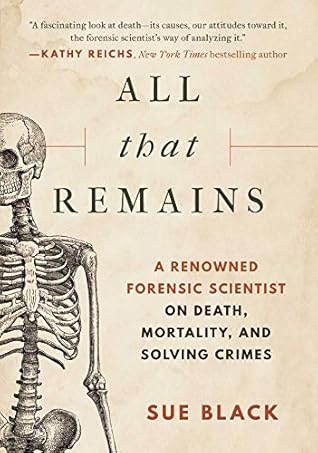More on this book
Community
Kindle Notes & Highlights
by
Sue Black
Since we can’t influence the creation of our lives, and their end is unavoidable, perhaps we should be focusing on what we can regulate: our expectations of the distance between them. Perhaps it is this we should be trying to manage more effectively by measuring, acknowledging and celebrating its value rather than its duration.
As a living person, you remain separate from death, but the mesmerising beauty of human anatomy has created a bridge into the world of the dead, one that few will cross and none who do will ever forget. The sensation of traversing that bridge for the first time is an experience you can never repeat. It is special.
Somewhat ironically, those with the shortest shelf life are the ones that start it all off: sperm survive for only three to five days after formation. Skin cells live for a mere two to three weeks and red blood cells only three or four months. Not surprisingly, there is greater longevity in the tissues and the organs. The liver takes a full year to replace all its cells and the skeleton almost fifteen years.
The four permanent cell types are the neurons in our nervous system, a tiny little area of bone at the base of our skull called the otic capsule, the enamel in our teeth and the lenses in our eyes.
The nutrient building blocks required to construct our otic capsule were supplied by Mum from what she was eating around sixteen weeks into her pregnancy. So within our head, in that minute piece of bone just big enough to hold four raindrops, we will perhaps carry for the rest of our lives the elemental signature of what our mother had for lunch when she was four months pregnant. Proof, if any were needed, that our mums never leave us, and a whole new perspective on the mystery of how they manage to get inside our heads.
‘Life is pleasant, death is peaceful. It’s the transition that’s troublesome.’
CHAPTER 5 Ashes to ashes ‘The measure of life is not its duration, but its donation’ Peter Marshall pastor (1902–49)
The stark truth is, of course, that grief never dies. The American counsellor Lois Tonkin reminds us that loss isn’t something we ‘get over’, and it doesn’t necessarily lessen, either. It remains at the core of us and we just expand our lives around it, burying it deeper from the surface. So with time it may become more distant, more compartmentalised and therefore easier to manage, but it does not go away.
The bereavement theory developed in the 1990s by the Dutch academics Margaret Stroebe and Henk Schut suggests that grief works in two primary ways and we oscillate between them. Their ‘dual process’ model of grief defines these as ‘loss-oriented’ stres-sors, where we are focused on our pain, and ‘restoration-oriented’ coping mechanisms involving activities that distract us from it for a while.
If the purpose of consoling the bereaved while honouring the dead is fulfilled, then who are others to stipulate how this should be done? Equally, tradition still matters for as long as there are those who gain comfort from it.
They both felt that when they were dead, they were dead and they didn’t really care about where they were buried as long as it was done properly. They may have been traditionalists, but they were also practical and unsentimental. Father always promised he would wave to Mother from the top of the hill and she always retorted that she’d ignore him.
The anonymity of human remains deadens our empathetic responses but such is the power of forensic anthropology that it can reinstate identity and rekindle the human instinct to care and protect.
Unwilling to acknowledge that we shrink with age, we continue through our lives to claim the height we were in our prime, even though we become shorter whether we like it or not. Once we pass forty we lose about a centimetre every decade and, after seventy, a further three to eight centimetres.
And believe it or not, our height varies according to the time of day: we are on average half an inch shorter by the time we go to bed than we were when we got up. We lose most of that height within three hours of rising, as our cartilages settle and compress and decrease our joint spaces.
The ‘out of Africa’ concept, which classified the first ancestral group as people originating from sub-Saharan Africa, still holds firm. The second group stretched from North Africa across Europe and east to the border with China. The third encompassed the eastern regions of the Asiatic land mass and, across the North Pacific Ocean, the North and South Americas and Greenland. The fourth, more geographically isolated, region consisted of the South Pacific Islands, Australia and New Zealand. This resulted in the four archaic classifications of Negroid, Caucasoid, Mongoloid and Australoid.
We have many of these lymph nodes scattered throughout our bodies, but there is a high concentration of them at the top of our limbs, in the groin and armpit in particular. At these sites they act a bit like a sink trap in a shower that collects hair: as the ink molecules are too big to pass through the nodes, the dye accumulates there. Which is why, in people with tattoos, the nodes eventually take on all the colours of the inks.


